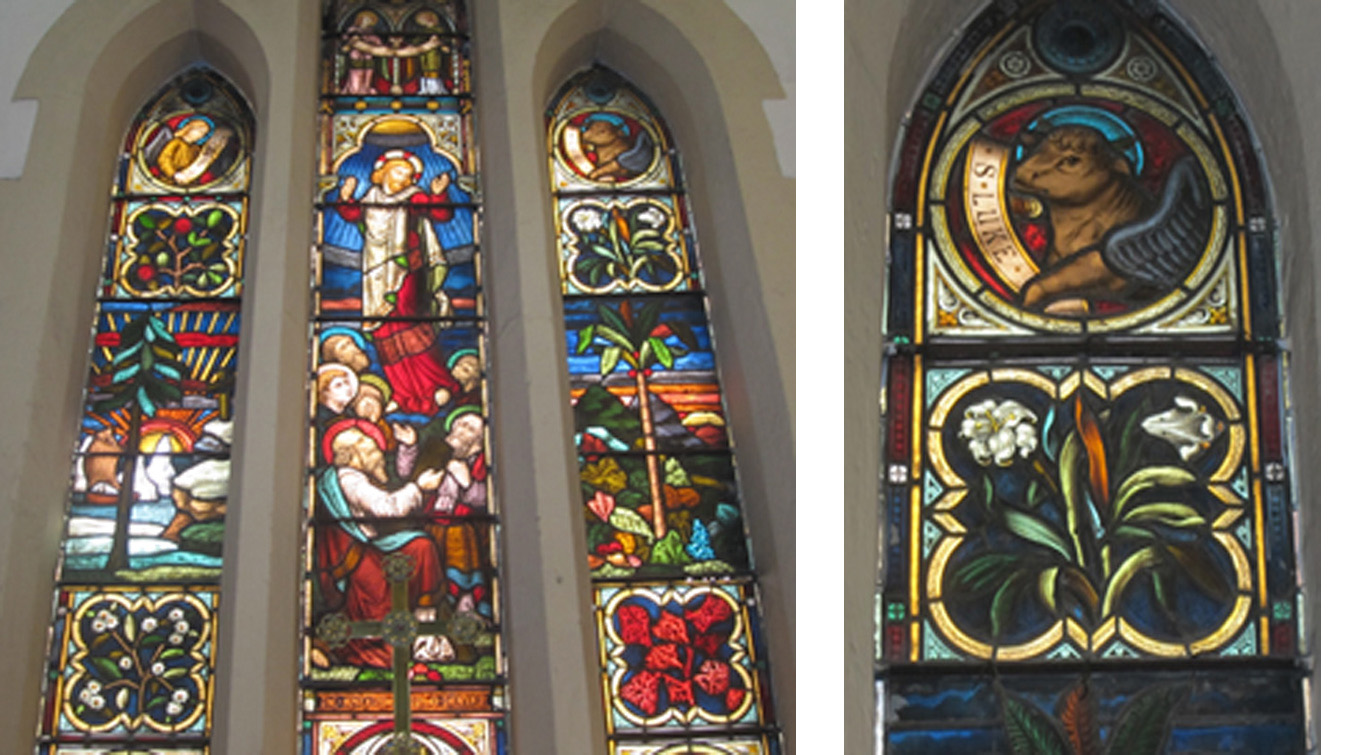Do you see the lily?

How often do you look at the stained glass windows in your church? Every time you attend perhaps but do you really LOOK at the enormous detail and perhaps try to decipher the stories it tells? Do you know the significance of the symbols or flowers? Note that our Anglican churches face the east and on the occasion of the annual early morning Easter Mass the colours come alive as the rising sun strikes the glass and enhances the beautiful colours.
At Easter we focus on the Resurrection of Jesus Christ and all that this represents. High on the list symbols is the Easter lily (Lilium longiflorum). It is known as the Easter lily because it has become the symbol of the Resurrection. Jesus himself made reference to the lily in the Sermon on the Mount “ Consider the lilies of the field, how they grow; they neither toil nor spin, 29yet I tell you, even Solomon in all his glory was not clothed like one of these”. [Matt. 6:28-29]. The Easter lily embodies life, hope and joy. It is not surprising then that the lily is shown in many stained glass windows as it is a representation of the Resurrection. Is there a lily in your window?
The craft behind the glass

But the lily is only a small part of the story of a stained glass window. How does it get there? Where does it fit into the story? The answer to this is important because it is easy to take the magnificence of the window for granted. How do they come to be and how should we care for them? To pursue the answer to these questions the writer had a conversation with Mrs. Charmaine Thompson, well known for her artistic talent in the production of stained glass pieces and windows. She has designed and manufactured windows for many churches around the island. Indeed, she has repaired many more.
Uncertain about how to occupy herself gainfully while caring for a clergy husband – [now Rt. Rev. Robert Thompson] and two small children, she embarked on learning the intricacies of stained glass manufacture. Her first major test, under the instigation of the then Rev. Canon [now Rt. Rev.] Harold Daniel, was the restoration of the window at St. Patrick’s Church, Windward Road, after damage by Hurricane Gilbert in 1988. The rest is history as she, an artist in her own right, continued her practical studies overseas at every opportunity and has now worked almost thirty years in this business.
She herself performs and manages all the processes of producing a stained glass window. The process is the same whether done by a company or, as in her case, singlehandedly. The procedure involved is complex and time consuming. There are several stages.
- Designer stage – This requires a true artist and close dialogue with those who have requisitioned the piece. The position, size and interpretation must be very clear.
- Cartoonist – This person takes the design further and configures the size and shape of the separate pieces which comprise the entire window.
- Glass cutting – based on the previous work the glass cutter selects the coloured glass and cuts these to fit the shapes.
- Stained glass artist – This person paints the glass.
- Glaziers – This person, or persons, put the pieces together, fusing them with lead. Lead is used because it is strong and pliable and also because where there are temperature extremes it expands in the heat and contracts in the cold. It therefore affords protection for the glass.
- Finishers – this persons applies putty to crevasses between the lead and the glass. The putty strengthens the structure. The glass is then cleaned and polished.
- Installers – These persons install the stained glass piece into the space for which it was made.
Maintenance and repair

Some glass pieces can take a few years to manufacture but the length of time depends on the complexity of the design. Much of the challenge with repair is to dismantle the piece without causing further damage. The greatest threat to a stained glass window is impact by a hurricane or missiles – which apart from a hurricane can be the result of careless action. Protection of the glass is a critical element to its ownership and maintenance. Most damage is inflicted from the outside but because many major pieces are at some height from the ground this is infrequent. There is some natural deterioration over the years as the lead gets old and crystallizes. It can then weaken and break as it can no longer support the glass.
Key to the repair process is the use of photographs. Churches are strongly advised to photograph their stained glass windows from a distance and to zoom into sections to record detail. These photographs should be carefully stored as they are critical to the repair process in showing the shape of separate pieces, and details of the colour and textures of the glass used therein. Should a stained glass fixture fall out of its frame it should on no account be allowed to lie flat. It must be stored in a vertical position until maintenance work can be effected.
How does the window speak to you?

Other than being beautiful and artistic, many windows tell a story. What do they tell you? Many of the older stained glass windows in our Parish churches were supplied from overseas. Mention can be made of the Three Light (Three Mary’s) (north) window at St. Andrew Parish Church which was donated by George Stiebel in memory of his wife Madeline who died in 1892. The possibility of repair by overseas personnel is beyond the budget of our local churches. So is the possibility of insurance with replacement in mind. The care and protection of these valuable assets which comprise history, art, master craftsmanship to say nothing of liturgical significance are an awesome responsibility and cannot be taken lightly. The exacting skill, physical strength and artistic interpretation along with the handling and awareness of variable materials present innumerable challenges.
So the next time you look at a stained glass window – seek out the Easter lily if it is there. The symbol of the Resurrection, new life, promise and hope. Think of the story behind the glass and remember gratefully those who – over the centuries – have used their talents and spiritual gifts to uplift us through this medium.
– Elsie Aarons

